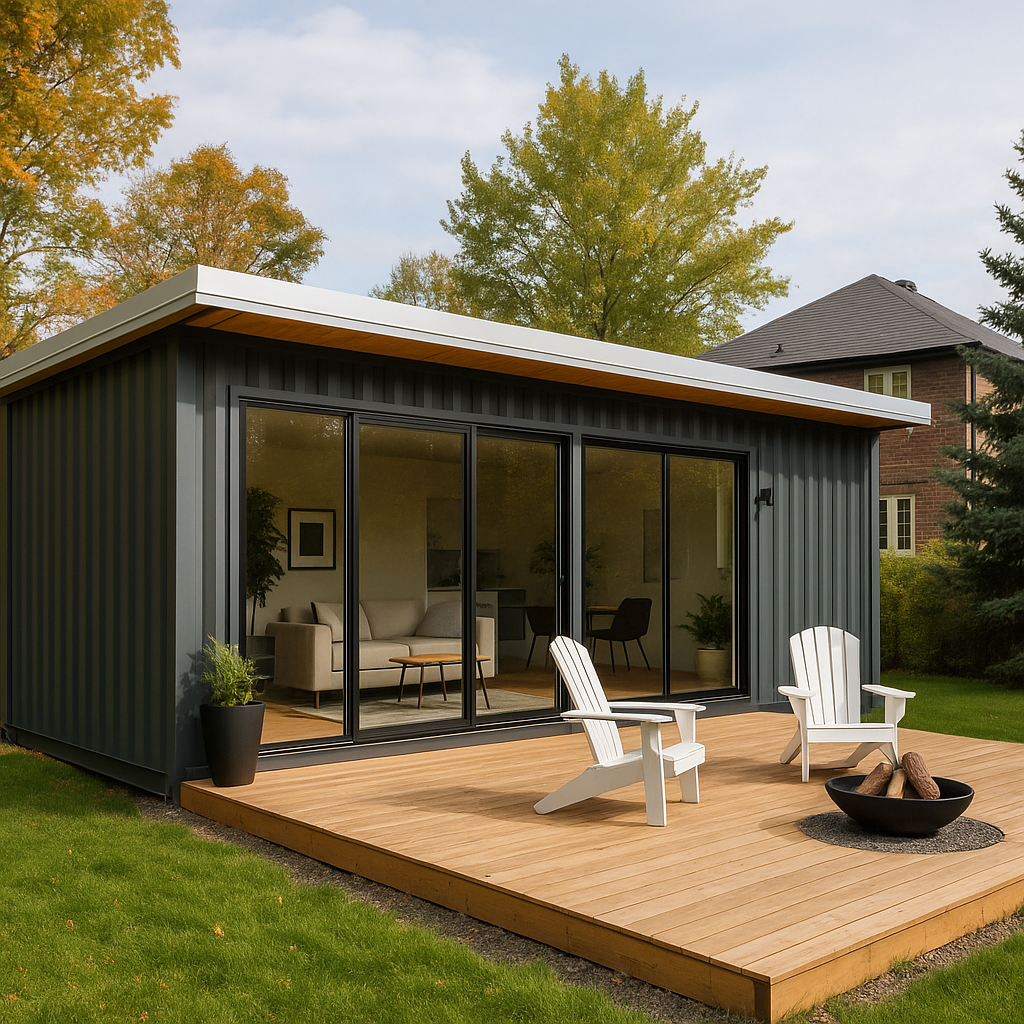
Estimated reading time: 10 minutes
Key Takeaways
- Cost-effective Housing: Shipping container ADUs offer affordable living options while addressing housing shortages.
- Modular & Fast Construction: Their modular design allows for quick build times and easy expansion.
- Sustainable Building: Repurposing steel and energy-efficient features make them eco-friendly.
- Customizable Designs: Adaptable layouts meet various needs—from multigenerational living to rental income.
- Regulatory Navigation: Understanding local bylaws and permitting processes is key to success.
Table of Contents
Shipping Container ADU: A Practical Solution for Affordable Housing in Canada
Shipping container ADUs are rapidly gaining popularity as affordable and innovatively designed housing solutions across Canada. A shipping container ADU (Accessory Dwelling Unit) is not just a creative twist on backyard suites, but also a practical answer to the country’s housing affordability crisis. Whether you live in Toronto, Vancouver, or a smaller Canadian city, the buzz around shipping container homes is growing for good reason.
With rising real estate prices and limited space in urban centres, more Canadians are exploring alternative housing options. This blog post will walk you through what a shipping container ADU is, the benefits and process of building one, and actual Canadian case studies showcasing these modular housing marvels. If you’re thinking about adding value and space to your property or seeking affordable housing alternatives, read on.
For additional insights, check out affordable housing solutions and our Accessory Dwelling Units guide.
Benefits of Shipping Container ADUs
Cost-Effectiveness & Affordability: Affordable Housing with Shipping Container ADU
Shipping container ADUs are typically 20%–40% more affordable than conventionally built homes, thanks to their modular and pre-manufactured nature.
Major affordability factors:
- Prebuilt Structure: The main frame is already assembled, reducing labour and material costs.
- Shorter Build Time: Accelerated construction timelines cut soft costs like site management.
- Lower Foundation Costs: Simpler foundations lower overall site preparation budgets.
These savings help more Canadians access new living spaces or generate rental income with lower upfront investments. Learn more about affordability in innovative housing strategies.
Modular Construction Advantages: Modular Construction for ADU Design
Modular construction is key to achieving rapid delivery and design flexibility.
Key modular benefits:
- Fast Assembly: Shipping container ADUs can be built in weeks or a few months.
- Expandability: Additional containers can be added as the need for space grows.
- Custom Layouts: Containers can be stacked, joined, or separated for creative, functional designs.
For more on modular design, visit our modular homes guide.
Sustainability & Eco-Friendly Aspects: Shipping Container Homes for Affordable Housing
Shipping container homes excel in sustainability compared to traditional residential builds.
Environmental benefits:
- Repurposing Steel: Each container diverts roughly 7,500 lbs of steel from waste.
- Energy Efficiency: With closed-cell spray foam insulation and triple-pane windows, heating and cooling demands are lowered.
- Reduced Construction Waste: Off-site fabrication minimizes environmental impact and debris.
Explore further with our guides on tiny sustainable living and energy-efficient tiny homes in Canada.
Customization & Versatility in ADU Design: Flexible Shipping Container ADU Living
Shipping container ADUs are customizable to meet personal style, regulatory requirements, and environmental conditions.
Customizable options:
- Interior Layout: Options include studio, one-bedroom, or two-bedroom configurations.
- Exterior Finishes: Tailor cladding to blend in or stand out.
- Smart Features: Incorporate radiant floor heating, smart thermostats, or off-grid systems. Enhance your project with smart home technology for ADUs.
Canadian architects excel at adapting designs for optimal insulation, accessibility, and energy performance. Discover more about accessible design here.
The ADU Design Process Using Shipping Containers
Planning and Zoning Considerations: Shipping Container ADU Land Use
The process begins with a thorough review of municipal and provincial planning requirements.
Step-by-step:
- Check Local Bylaws: Confirm that shipping container ADUs are allowed in your area—review setbacks, lot coverage, and permitted uses.
- Pre-Application Meeting: Consult with local planners before finalizing your design.
- Permit Application: Submit drawings, site plans, and engineering reports for approval. For Ontario-specific rules, see ADU regulations Ontario and for broader guidelines, reference container homes legality in Canada.
Some regions, like Ontario and BC, have eased regulations to encourage ADU development. Additional details can be found here and in Bonfield Township bylaws.
Design and Layout: Shipping Container Homes for Canadian ADU Design
Selecting the best container size and planning your interior/exterior configuration is crucial.
Key design considerations:
- Container Size: Standard choices include 20-foot and 40-foot containers, or a combination for larger spaces.
- Insulation: Closed-cell spray foam is optimal for moisture control and high R-value performance.
- Thermal Envelope: Strong vapor barriers and airtight seals are essential for Canadian winters.
- Energy Efficiency: Incorporate low-E windows and LED lighting to reduce long-term utility costs.
For more detailed design insights, visit our pages on container homes in Canada and modular homes for green builds.
Modular Construction Techniques: Building a Shipping Container ADU
Construction transforms used containers into safe, modern living spaces.
Key steps include:
- Structural Modifications: Cut out openings for doors and windows and reinforce framing for safety.
- Heating/Cooling: Integrate HVAC systems, radiant flooring, or heat pumps to combat harsh weather.
- Electrical/Plumbing: Ensure efficient setup that ties into local municipal utilities.
- Inspections: Schedule thorough building inspections at every stage to guarantee code compliance.
These methods are designed to produce durable ADUs that thrive in Canadian climates. More insights can be found here.
Permitting & Inspection Process: Shipping Container ADU Regulations
Like any new residential unit, shipping container ADUs must comply with local building codes and pass inspections.
Permit steps:
- Submit Detailed Plans: Provide engineered drawings, fire safety documentation, and energy statements.
- Obtain Building Permits: Secure official approvals before construction begins.
- Inspection Schedule: Foundations, framing, electrical, and plumbing are inspected before occupancy.
Collaborating with experienced professionals streamlines this process. For further guidance, check out our resources on ADU permitting in Ontario and in British Columbia.
Canadian Case Studies of Shipping Container ADUs
Case Study 1: Ontario Backyard Suite – Real Canadian Experiences
- Zoning Review: Initiated with a pre-application review to understand setbacks and size requirements.
- Insulation: Custom spray foam insulation and triple-glazed windows ensure comfort year-round.
- Build Timeline: Completed in six months from start to finish.
- Cost Savings: Achieved approximately 30% cost reduction compared to traditional construction.
- Unique Challenges: Overcame decontamination and strict city setback rules.
This project now serves as a warm and private suite for a family member. Explore more on multigenerational living with ADUs and read additional Canadian ADU success stories.
Case Study 2: East Coast Rental Unit – Modular Construction Meets Affordable Housing
- Design: Two 20-foot containers were stacked and joined to create an 800-square-foot rental unit.
- Features: Energy-efficient windows, a green roof, and premium insulation tackle coastal weather.
- Timeline: Completed in just under five months, with only minor delays for utility hookups.
- Performance: Met strict provincial energy codes, reducing heating costs and boosting rental appeal.
This unit now provides steady rental income while contributing to sustainable housing. For further rental optimization tips, visit maximizing rental unit profitability.
Case Study 3: Vancouver Laneway Home – ADU Design and Container Innovation
- Layout: A two-storey 480-square-foot ADU was created by stacking containers to maximize a challenging lot.
- Bylaw Challenges: Customized plans met strict municipal laneway housing rules.
- Insulation Expertise: Advanced techniques provided high performance in wet coastal climates.
- Purpose: Designed for visiting family and Airbnb rentals, providing flexible living solutions.
This case demonstrates how container ADUs can succeed even in tough urban markets. For related information, see our guide on ADU regulations in BC.
Challenges and Considerations
Permitting and Zoning Complexities: Regulatory Hurdles for Shipping Container ADUs
Not all municipalities readily approve shipping container ADUs. Each locality may impose unique restrictions and processes.
Potential challenges include:
- Restrictions: Some cities ban or limit container use, while others strictly control appearance and location.
- Varied Interpretations: Definitions of “ADU” or “secondary suite” can differ between jurisdictions.
- Documentation: Multiple engineered plans, environmental assessments, and neighbour notifications may be required.
Early consultation with local officials is crucial. For regional insights, refer to the Ontario ADU zoning guide and explore BC shipping container bylaws.
Insulation and Climate Considerations: Making Shipping Container Homes Canadian-Worthy
Standard shipping containers require significant upgrades for year-round Canadian living.
Best practices include:
- Closed-Cell Insulation: Essential for preventing condensation and safeguarding indoor comfort.
- Vapor Barriers: Keep moisture at bay to maintain a comfortable environment.
- Smart HVAC Solutions: Using mini-splits, electric baseboards, or radiant floors ensures consistent temperatures.
Failing to properly insulate can result in mold, rust, and escalating heating bills. See tips on winter-proofing tiny homes and energy efficiency in Canadian tiny homes.
Structural Safety & Contaminant Removal: Optimizing ADU Safety
Used containers may require remediation of chemical residues and structural reinforcement.
- Floor Replacement: Remove original plywood floors and replace with toxin-free, residential-grade materials.
- Engineering Reinforcements: Strengthen openings for doors and windows to ensure safety.
A professional inspection is essential for a safe and legally compliant build. More details are available here.
Local Code Compliance: Meeting Canadian Standards for Shipping Container ADUs
Regulations vary widely between provinces, cities, and neighbourhoods.
- Setbacks & Size Restrictions: Municipalities dictate minimum distances, maximum sizes, and unit heights.
- Energy & Safety Standards: Compliance with provincial energy codes is mandatory.
- Permissions: Some areas require neighbour consultations or heritage reviews.
Always verify local requirements before purchasing containers or starting designs. For Ontario requirements, see ADU regulations Ontario and Bonfield Township’s shipping container bylaws.
Conclusion
Shipping container ADUs represent one of Canada’s most promising approaches to affordable, innovative housing. They combine cost-effectiveness, sustainability, and flexibility through modular construction and smart design.
With proper planning, professional guidance, and early engagement with local officials, many challenges—from regulatory hurdles to climate adaptations—can be overcome. Whether you aim to add rental income, accommodate family members, or embrace eco-friendly living, shipping container ADUs offer a compelling solution.
Ready to get started? Contact a local expert today and explore the potential of your shipping container ADU project!
Frequently Asked Questions
Q1: What exactly is a shipping container ADU?
A shipping container ADU is an accessory dwelling unit made from repurposed shipping containers. It serves as a secondary, self-contained living space—ideal for rental units, home offices, or multigenerational living.
Q2: Are shipping container ADUs cost-effective?
Yes. Due to prebuilt structures, shorter build times, and lower foundation costs, these ADUs are generally 20%–40% cheaper than conventional constructions.
Q3: How do I navigate the permitting process for a container ADU?
Begin by checking your local bylaws and regulations, scheduling a pre-application meeting with planning officials, and preparing detailed engineering and design plans. Consulting with an experienced architect can also streamline the process.
Q4: Can container ADUs be customized to suit different needs?
Absolutely. Options range from interior layouts to exterior finishes and smart features, allowing you to tailor your ADU to your lifestyle and local requirements.
Q5: What environmental benefits do container ADUs offer?
They repurpose steel, reduce construction waste, and incorporate energy-efficient features, making them a sustainable housing option.

Leave a Reply